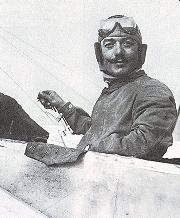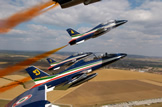Definition
Acrobatic flight is a manoeuvre or a series of manoeuvres which give the aeroplane abnormal, dangerous and difficult positions in flight, in order to give a spectacular show. From a military point of view, acrobatic flight is very useful for the fighter pilots because it allows them to put themselves in a position of advantage with respect to the enemy, both to defend themselves and to attack. In fact, if a fighter pilot is more expert than another, he can carry out manoeuvres that the other cannot perform; at the same time he will do nothing but try and imitate him.
(fron the the French Encyclopaedia)
The beginnings
Acrobatic flight was not the result of a pilot's exhibitionism, nor was it the result of a desperate manoeuvre carried out while fighting for survival. It was born out of the reflections of a French aviator: Adolphe Pegoud. On September 2nd 1913 at Juvisy (France) in front of a wide public he carried out what he thought was the first loop (one of the most dangerous manoeuvres) in the history of flight . He didn't know that he had been preceded in his masterpiece by the Russian Nicolajevic Niesterov, who had flown a loop six days before. Niesterov's manoeuvre was unknown to the press for a long time. After that, Pegoud devised and carried out a complete roll, which is still considered one of the classic manoeuvres in acrobatic flight.
The two pilots had different approaches to acrobatic flight: for Pegoud it was a means to show the full reliability of the aeroplane in every attitude of flight, while Niesterov had known immediately the value of the aeroplane as an instrument of war.
Adolphe Pegoud 
The fundamental use of collective acrobatic flight was explained in the year 1916 by the German pilot Lt. Oswald Boeckle: " Humans are not the conquerors, but they dominate the atmosphere". Born in 1891, in 1914 he was recruited in the German military aviation and got the licence of military pilot in four weeks. He had his fire baptism in France where he was sent to the reconnaissance group, and he revealed from the very beginning an uncommon talent for flight. At the beginning recon was unarmed, but, with the use of aircraft armed with machine guns, the situation changed and Boeckle started his collection of shot-down airplanes by bringing his craft to aiming position and leaving the observer to pull the fryer. In 1916, when he had already gained 18 air victories, he was sent away from the battle field to be used for teching his comrades the theory and praxis of single-seater fighting. Success came soon and the Staffel-Leader was satisfied with his students, as they were with him. On 28. October 1916 Oswald Boelcke was killed after he had been successful in 40 dogfights.
